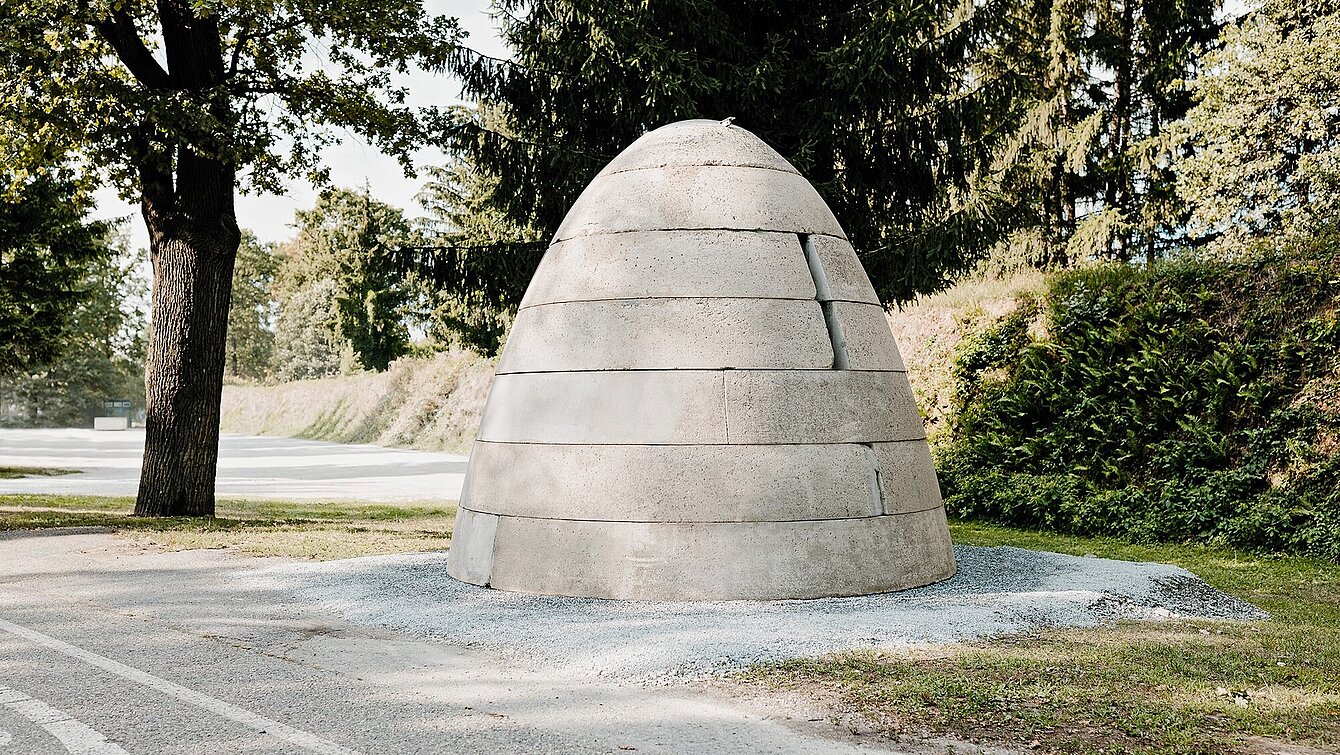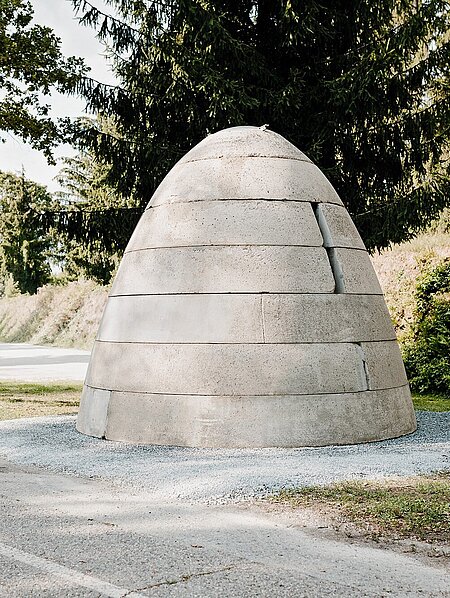Invited to take part in the Concrete Art project as part of Graz European Capital of Culture 2003, he developed the Beehive Bunker, which is about four meters in diameter and 3.5 meters high. Its shape, which is unusual for a bunker and reminiscent of a warhead sticking out of the ground, a sugar loaf or a beehive, reflects discrepant levels of meaning that Chris Burden deliberately uses to illustrate the absurdity of any warfare. He thereby provocatively reflects the exposure and warlike aggression produced by humans in physical borderline experiences. At the same time, the helplessness of defenceless civilians is illustrated in the form of this sculpture as a memorable signature and striking inscription in its surroundings.
Beehive Bunker
Chris Burden, 2003


Image Credits
Author
Elisabeth Fiedler
Location on map
Position 78
Owner
Graz-Köflacher Bahn u. Busbetrieb GmbH (GKB); Stadtgemeinde Deutschlandsberg
Artist biography
Show all
About the sculpture
The American performance artist and sculptor Chris Burden (1946–2015) was one of the most important instigators and radical protagonists of body art, which he began practicing in the 1970s, also in reaction to the never-ending Vietnam War. Acting as a provocateur of the subculture who anticipated the fury of the punks, he often exposed himself to extreme to almost self-destructive situations. As part of his 1971 master’s thesis entitled Five Day Locker Piece, he shut himself into a locker for five days with just a five-gallon container of drinking water and a urine bottle. That same year the shocking video work Shot appeared, in which Burden had a friend shoot him in the arm in a gallery. In the performance Trans-Fixed (1974), he had himself nailed in a cross-like pattern to the hood of a VW Beetle. After his work Doomed (1975), in which he lay down under a heavy glass plate in the MCA (Museum of Contemporary Art Chicago) and stated that he would remain there until the museum staff halted the action, which, despite his physical distress, only happened after 45 hours, he increasingly turned away from body and performance work. He continued to develop his focus on sociological, political and socially relevant problems and issues, in which he dealt significantly with the aesthetics and ethics of power, in sculptures and conceptual installations.
War equipment such as tanks, submarines, warships and weapons are components of his artistic vocabulary, which is used critically in real and sometimes modified form.
Invited to take part in the Concrete Art project as part of Graz European Capital of Culture 2003, he developed the Beehive Bunker, which is about four meters in diameter and 3.5 meters high. Its shape, which is unusual for a bunker and reminiscent of a warhead sticking out of the ground, a sugar loaf or a beehive, reflects discrepant levels of meaning that Chris Burden deliberately uses to illustrate the absurdity of any warfare. He himself writes about the work: “I designed a small, three-person bunker, which I called the Beehive Bunker because of its shape. […] The Beehive Bunker is intended as an incredibly cheap defensive element. The combatants would enter through an opening from above and then advance and lock a metal bolt from the inside. Like old castles, the Beehive Bunker is provided with three vertical loopholes through which the occupiers can fire their weapons. The Beehive Bunker would also protect the combatants inside from small arms fire. [...] I planned it because it could be really useful in the current combat scenario; many Beehive Bunkers would be necessary to form an overall axis of power. I believe that Beehive Bunkers would be harder to destroy than rectangular structures because of their simple conical shape. Essentially, they always present a curved surface for the projectiles’ line of fire. Besides the functional component, there is also the aesthetic appeal of this structure, which ironically has the shape of a bullet.”1
He thereby provocatively reflects the exposure and warlike aggression produced by humans in physical borderline experiences. Upon closer inspection, we can see three loopholes and an entrance aid on the ring-shaped sculpture, which, however, is too high to get into. The ambivalence of concentrated force as a demonstration of power and a protective shell, of representation and concealment, confirms the ambiguity as a conscious questioning of human communication, confrontation and isolation. The hypertrophy of male occupation and dominance behavior and violence becomes just as visible as the senselessness of claims to power and property. At the same time, the helplessness of defenseless civilians is illustrated in the form of this sculpture as a memorable signature and striking inscription in its surroundings. In this clear exaggeration of the symbol, which relentlessly points to destruction and self-destruction, to the actual cynicism, Chris Burden explains the form and function of a bunker for three people. On the one hand, he poses as a clever advisor to war strategists by referring to the small surface of attack due to the avoidance of right angles in the aesthetic shape. On the other hand, in its title he gives the sculpture a euphemistic attribution of a bunker as a beehive. This is art’s answer as a challenging question to the claim of perfection that war equipment stakes according to the system of “form follows function.”
1 Chris Burden, “Beehive Bunker,” Concrete Art. Ein Projekt von Graz 2003 – Kulturhauptstadt Europas in Kooperation mit der Bauwirtschaft Steiermark und Werkstatt Kollerschlag, ed. Edelbert Köb (Graz: Graz 2003), 12.



















